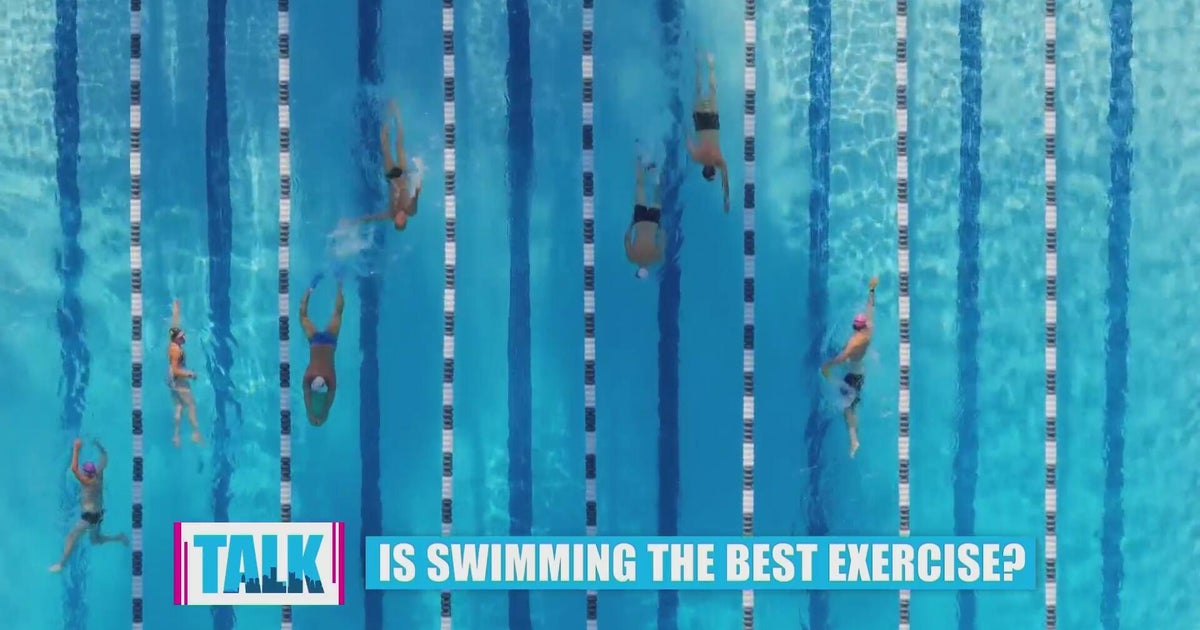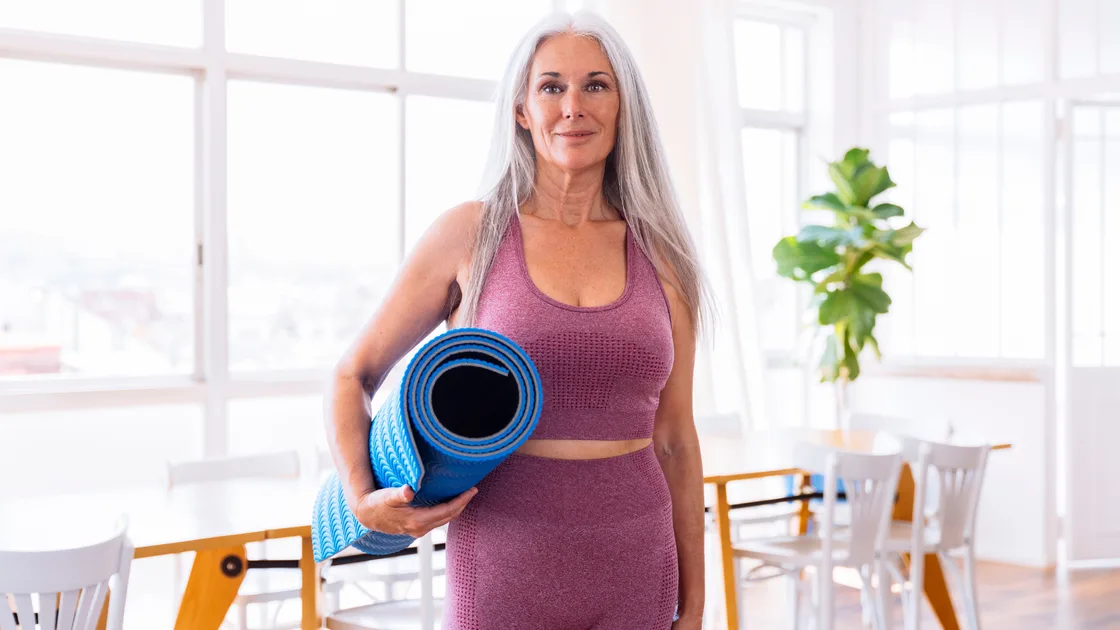Fitness
Lazy exercise is still exercise. How to make the most out of your workout by doing the least.
There are some people who can’t get enough when it comes to exercise — the ones who are up at the crack of dawn for a jog, who squeeze in a class during their lunch break and prioritize boot camps over brunch on the weekends.
And then there are the rest of us. We know we need to exercise — for at least 150 minutes per week, plus two days of muscle-strengthening activities, per the Centers for Disease Control and Prevention — but we don’t necessarily want to. Or maybe we struggle to find the time (not to mention the energy), get easily bored or feel out of our element (and out of shape) at the gym.
Enter: lazy exercise. Yes, there are ways to incorporate movement and exercise into your life without doing the whole no-pain-no-gain thing, or pushing yourself too far out of your comfort zone. Here’s how.
Focus on getting more steps in
Many people aim to walk 10,000 steps per day. Though you don’t actually have to hit this specific number, you can at least focus on beating your weekly average step count (which your smartphone or fitness tracker can measure). Walking comes with all sorts of health benefits, and it’s a simple way to ensure you’re spending less time sitting around (which is not so great for you).
The good news about people who dread exercise? Walking is pretty low-key and easy to work into your day. If you hate how much time exercise takes in your busy life, try getting in some extra steps while you’re busy doing errands (like, say, at the mall); sneak in some laps while your kids play at the park; walk to the store to grab stuff for dinner instead of taking your car; or take work phone calls while pacing around your office.
Try a micro exercise class
Does a 45-minute class feel like too much of a time commitment? Kira Jones Matousek, founder and CEO of the fitness app Cacti Wellness, tells Yahoo Life that her app features short workout videos — all under 20 minutes — in order for people to build exercises into their life in sustainable ways.
“My big mindset around wellness and working out is that it’s all about consistency and building habits that you can actually stick to,” Matousek says. “If you’re more likely to do 10 minutes of core every day than going just once a week to a really hard workout class, when you are then sore and don’t have the energy to go back … then it becomes a lifestyle.”
Look for apps or YouTube videos that offer shorter workouts that are simple to squeeze in — like when you need a break between Zoom meetings or are waiting for your dinner to cook.
Pair your exercises with something cozy — or fun
TikToker Hope Zuckerbrow introduced the world to “cozy cardio” when she shared her morning routine, which includes waking up early, making herself a fun beverage (like a protein coffee) and then using a walking pad while watching her favorite TV show. Zuckerbrow didn’t even change out of her fuzzy socks in order to get her steps in.
Research says that associating walking with something that makes you feel good (like, say, watching the latest episode of Vanderpump Rules) is an example of pairing — and it can help the habit stick. So, if you can only catch up on your reality TV drama when you’re on the walking pad, that might just be the incentive you need to keep it up.
Work out while you work
If much of your job is answering emails and Slack messages, consider doing it from a treadmill, says Matousek. She says you should walk at a pace where you are putting a little effort in, but can very comfortably keep up a conversation. “Then up the incline a little bit,” she says. Doing so is a “sneaky way to recruit your muscles,” such as your glutes, calves and posterior chain. Since you’re likely focused on sending out emails and communicating with co-workers, you might find that the workout (and work day) flies by.
Indulge in some “exercise snacking”
You don’t need to do a formal workout class in order to benefit from this form of “lazy” exercise. Try what’s called “exercise snacking,” which are short bursts of activity throughout your day. Maybe that means a few rounds of push-ups in between meetings, and then a couple of sets of squats when your day is done.
These exercise snacks can spike your heart rate (important, considering how we do need those 150 minutes of moderate-intensity exercise per week) but they’re way easier to fit into your life than a sustained cardio workout.
While you may not feel like you’re getting a full workout in, these snacks add up, breaking up sedentary time and helping you burn calories and build muscle.
Try the “Lazy 45” circuit
Sometimes, you find yourself in the gym with almost no motivation to move your body. David Mason, sports coach and founder of travel fitness website Barbells Abroad, tells Yahoo Life that when he feels that way, he aims for the “Lazy 45,” in which he picks three or four different cardio machines (like the stair climber, elliptical, treadmill or rower) and switches them up every 10 to 15 minutes. “The beauty is if you’re feeling a little sluggish, the time slots are short enough to know each one is almost over as soon as you start,” he explains.
Lie down
Exercise that involves standing up? Don’t bother on extra lazy days. If you want to relax while still working out, why not aim for a mat workout instead?
Maeve McEwen, director of programming and head trainer at Pvolve, tells Yahoo Life that getting closer to the ground can encourage you to connect more with your muscles and overall feel more supported. Plus, McEwen says you can also “use props like the wall, balls, pillows or the ground to help alleviate fatigue and support your form,” she says.
There are a bunch of different workouts that involve lying down, including mat Pilates and stretching. Matousek’s Cacti Wellness has a side lying series, in which participants use resistance bands for leg exercises. “You can put your head in your hand, and it’s not going to make it less of a workout for your lower body,” she notes.
Sneak in lazy exercise into your daily activities
You don’t have to plan for lazy exercise all the time — which makes it the most convenient of all. Just tweak your basic routine to be a tiny bit more active or challenging. Here are some examples:
-
Take the stairs instead of the elevator
-
Use a resistance band to do some thigh work during a long work meeting
-
Make your chores more active, like putting some extra muscle into scrubbing your bathtub
-
Carry your kid’s backpack while walking home from school (it’s basically rucking)
-
Balance on one foot while brushing your teeth or cooking
-
Play an active video game
-
Add wrist or ankle weights while walking the dog
🏋🏽♀️ Fitness

Fitness
Want to get into strength training? Experts explain the top four options

Stone says that you don’t need to use much weight. Just a pound, or a kilo or two, will do it. Start slowly and increase the weight gradually.
“I would also strongly suggest that if you’ve never lifted weights before, go find somebody who knows something about it,” Stone adds.
Free weights and barbells are a good choice is you’re relatively healthy.Credit: iStock
Weight machines
This is probably the least intimidating option for the beginner. The machines offer stability and a fixed pattern of movement and they give beginners a chance to get familiar with the movements involved in strength training.
“Machines are a good way to start,” Escamilla says. “They’re safe and easy and you don’t need a lot of technique or skill to do them.”
Escamilla points out they also reduce the risk of injury, isolate muscles and help build confidence as you’re starting out. The machines also are more time effective.
“Start here and then you can gravitate to free weight and other options,” Escamilla said.
Resistance bands and tubes
These are the most portable options. They can help to build muscle, improve flexibility and balance, and don’t require signing up for a gym membership. The bands or tubes are made of elastic and come in a variety of sizes and resistance levels.
Bands also come in fabric models.
“They take up no room to pack and they’re super-cheap,” Escamilla said. “You can take them with you as you travel – just throw them in your suitcase.”
You can use them to work your legs, arms, back, chest and shoulders and other muscle groups. They can be used in many configurations and may be less intimidating than dumbbells or barbells.
Loading
“The bands won’t cut it for a 300-pound (140kg) football player,” Escamilla says. “But they’re good for your average person — your average adult.”
Body weight resistance
The idea with every weight-resistance exercise is to overload the muscles. Your own body weight can be used to do this.
Exercises such as push-ups, pull-ups, squats, lunges and planks and others fall into this category.
“Your body weight can be used as a form of resistance,” Escamilla said. “You can get a good workout doing these and you need almost no equipment.”
No matter the option, Stone emphasises the need to vary your exercises — both the types and the number of repetitions. You can also vary locations, perhaps choosing an outdoor gym for your workouts.
Outdoor gyms are often found on beaches such as the one at the popular Barceloneta beach in Barcelona, Spain.
“You can’t do the same number of sets and repetitions all the time and expect to get better results,” Stone said. “You get stale and monotony can set in.”
AP
Make the most of your health, relationships, fitness and nutrition with our Live Well newsletter. Get it in your inbox every Monday.
Fitness
Post-cancer exercise plan lowers death and recurrence rates, according to a study | – Times of India

Regular exercise has numerous benefits, including reducing the risk of chronic diseases like diabetes and heart disease. A recent study published in the New England Journal of Medicine found that cancer patients who participated in a structured exercise program had better outcomes, living longer without cancer recurrence and having a lower risk of death. The study’s findings suggest that exercise should be a key component of cancer treatment, helping patients live longer and healthier lives. By incorporating exercise into their care plan, cancer patients can potentially improve their survival rates and reduce the risk of recurrence of cancer.
The study tells how regular exercise lowers the risk of cancer recurrence
The clinical trial, conducted across multiple countries, followed nearly 900 patients diagnosed with stage II and stage III colon cancer. Participants had completed surgery and chemotherapy and were split into two groups: one group received structured exercise coaching twice monthly for the first six months, then monthly for three years, and the other group received usual care without specific exercise guidance.
The results of the study were striking
Those in the exercise group had a 28% lower risk of cancer recurrence or developing a new cancer. More significantly, they had a 37% lower risk of death from any cause during an eight-year follow-up period. Cardiovascular fitness and endurance also improved in the exercise group, as shown by a better six-minute walk test and VO₂ max results.
Experts suggest structured exercise should be a part of a cancer recovery plan
As CNN spoke with Dr. Leana Wen, the potential for exercise to revolutionize cancer treatment became clear. The study’s findings are significant, showing that exercise can substantially reduce the risk of recurrent or new cancers and death. According to Dr. Wen, these results could change cancer treatment protocols. Currently, patients often receive general advice to exercise after treatment, but many don’t receive structured support. She suggests that patients should have “exercise prescriptions” and healthcare providers should track their progress. Insurance companies might also consider covering health coaching for cancer patients, potentially reducing the need for costly treatments.
Why exercise helps fight cancer
According to Dr. Leana Wen, exercise doesn’t just make you feel good, it alters your body at a cellular and hormonal level, helping to:
- Regulate hormones like insulin and estrogen that are linked to cancer growth.
- Reduce chronic inflammation, which contributes to cancer progression.
- Enhance immune function, supporting your body’s ability to detect and destroy abnormal cells.
- Support a healthy body weight, which is a major factor in cancer recurrence.
- This multi-layered impact makes exercise a powerful, non-pharmacological tool for improving cancer outcomes.
Fitness
Is swimming the best exercise?

Watch CBS News
Be the first to know
Get browser notifications for breaking news, live events, and exclusive reporting.
-

 Politics1 week ago
Politics1 week agoSchumer to force Senate reading of Trump's entire 'big, beautiful bill'
-

 Business1 week ago
Business1 week agoNew L.A. Trader Joe's opens across the street from … another Trader Joe's
-

 World1 week ago
World1 week agoCommissioner and MEPs in Budapest to challenge Orban’s Pride ban
-

 Technology1 week ago
Technology1 week ago5.4 million patient records exposed in healthcare data breach
-

 Technology1 week ago
Technology1 week agoTesla says it delivered its first car autonomously from factory to customer
-

 Politics1 week ago
Politics1 week agoTrump administration takes on new battle shutting down initial Iran strike assessments
-

 World1 week ago
World1 week agoUganda’s President Museveni confirms bid to extend nearly 40-year rule
-

 News1 week ago
News1 week agoUS multinationals on track for minimum tax reprieve after G7 deal


















